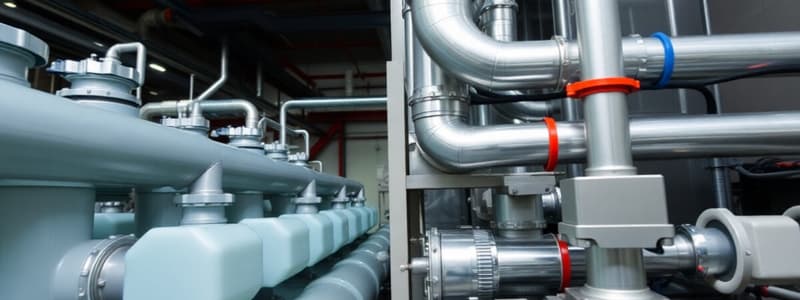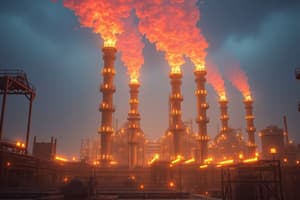Podcast
Questions and Answers
What is the primary function of the E-370 Deethenizer Condenser in the Propylene Refrigeration System?
What is the primary function of the E-370 Deethenizer Condenser in the Propylene Refrigeration System?
To condense the vaporized propylene as part of the refrigeration cycle.
How does the Propylene Accumulator D-500 manage non-condensable vapor?
How does the Propylene Accumulator D-500 manage non-condensable vapor?
It vents non-condensable vapor to the Purge Gas Header.
Describe the role of the C-500 Propylene Compressor in the system.
Describe the role of the C-500 Propylene Compressor in the system.
It compresses the overhead propylene vapor to a high pressure for further condensation.
What is the purpose of the lube oil system in relation to the C-500 Compressor?
What is the purpose of the lube oil system in relation to the C-500 Compressor?
What happens to the liquid propylene from D-510 before it is routed to E-370?
What happens to the liquid propylene from D-510 before it is routed to E-370?
How does the oil seal prevent lube oil leakage into the impellers?
How does the oil seal prevent lube oil leakage into the impellers?
What role does the seal oil reservoir play in the lube oil system?
What role does the seal oil reservoir play in the lube oil system?
What is the function of the electric heating coil in the Lube Oil Reservoir?
What is the function of the electric heating coil in the Lube Oil Reservoir?
Describe the purpose of the 3-way temperature control valve in the gear lube oil system.
Describe the purpose of the 3-way temperature control valve in the gear lube oil system.
What happens to the oil after it passes through the C-500 Lube Oil Filters?
What happens to the oil after it passes through the C-500 Lube Oil Filters?
Flashcards are hidden until you start studying
Study Notes
Propylene Refrigeration System Overview
- A single-stage, closed-loop refrigeration system designed for condensing propylene in E-370 (Deethenizer Condenser).
- Operates across low, medium, and high pressure stages.
Propylene Handling
- Make-up liquid propylene sourced from EU-1592 is routed to the bottom outlet of D-500 (Propylene Accumulator).
- Vaporized propylene from E-370 shell side goes to D-520 (Propylene Suction Drum).
- Liquid propylene at the bottom of D-520 can be flashed using high-pressure propylene.
Compression Process
- Overhead vapor from D-520 is directed to C-500 (Propylene Compressor) for high-pressure compression.
- The compressed vapor then travels to the shell side of E-500 (Propylene Refrigeration Condenser) for condensation via cooling water on the tube side.
- Condensed propylene returns to D-500 (Propylene Accumulator).
Non-Condensable Vapor Management
- Non-condensable vapor from D-500 is vented to the Purge Gas Header.
Interstage Process
- Medium pressure liquid propylene flows from D-500 to D-510 (Propylene Interstage Suction Drum).
- Propylene vapor from D-510 heads to mid-stage suction of C-500.
- Liquid propylene in D-510 drops to low pressure, returning to E-370 to restart the cycle.
Lube Oil System Components
- P-501A (C-500 Main Lube Oil Pump) transfers lube oil from the Lube Oil Reservoir to F-501A/B (Lube Oil Filters).
- Lube oil circulates to bearings of C-500 (Propylene Compressor) for lubrication and cooling.
Auxiliary and Recirculation Systems
- P-501B (Auxiliary Lube Oil Pump) ensures start-up and standby readiness.
- Lube oil from main bearings returns to the Lube Oil Reservoir; some is cooled via E-501A/B.
Buffer Gas for Oil Seals
- Buffer gas, propylene from the fourth stage of C-500, opposes lube oil pressure, preventing leakage.
- Small buffer gas quantities leak into the lube oil system and are diverted to the seal oil reservoir for degassing.
Seal Oil Reservoir Functions
- The reservoir enables degassing of lube oil, with overflow weirs facilitating recirculation to the Lube Oil Reservoir.
- An electric heating coil maintains lube oil temperature.
Gear Lube Oil Management
- P-502A (C-500 Main Gear Lube Oil Pump) manages gear lube oil via a 3-way temperature control valve.
- Gear lube oil flows through E-502A/B (Gear Lube Oil Coolers) and filters before reaching pump couplings and bearings.
Summary of Key Functions
- Essential components include the refrigeration system, lube oil pumps, seal oil management, and gear oil systems, all critical for maintaining efficient operation and preventing leakages within the system.
Studying That Suits You
Use AI to generate personalized quizzes and flashcards to suit your learning preferences.




